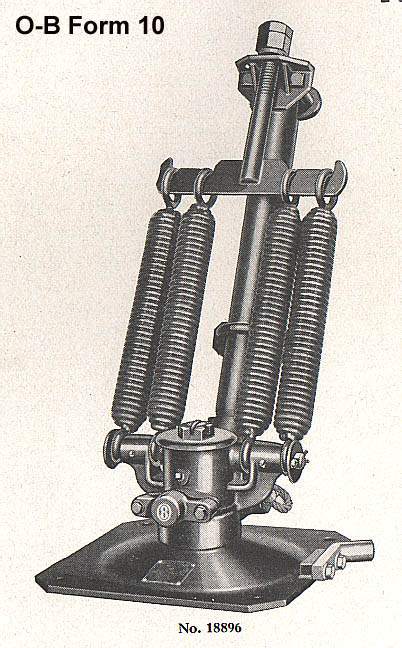
OPERATIONAL TROLLEY POLES FOR HO SCALE MODEL ELECTRIC STREETCARS AND INTERURBAN VEHICLES
by George L Huckaby and Dave Garcia
December 1998
As soon as I received my first HO train set in 1953, I wanted to model streetcars since they were my first love. Conventional wood and steel streetcars, including the famed "Nearside" cars were still in service all over Philadelphia. I used to ride them all over the Philadelphia metropolitan area until the fateful National City Lines rape of all the conventional cars and most of the unique properties that supported them.
In 1961, I obtained my first car, which incidentally is still operable. This Pennsylvania Scale Models (PSM) Brill Suburban Car was painted in the first of its eventual three paint schemes and ran beautifully on two rail track. But I wanted real overhead operation. After obtaining the PSM overhead wiring kit and installing such, it became obvious that this was not the method for powering the cars. It also became obvious that the trolley poles as originally supplied by Pennsylvania Scale Models (now Bowser) were not going to do either.
PROTOTYPE
Before discussing model trolley poles, we should consider the prototype. In the developmental stage of the electric streetcar, two major problems had to be solved. The first was getting electric current to the cars and the second was getting the power of the motor to the wheels. Frank J. Sprague, a Naval Academy graduate and electrical inventor, is generally given credit for practical solutions to both problems. After several almost outlandish methods proposed by other pioneers, Frank devised a spring loaded pole with a large wheel that contacted the underside of a suspended wire and the trolley pole was born. After streetcars got longer, faster and heavier, trolley poles and the bases became a science all to themselves. There were several manufacturers, both well known and somewhat obscure, of trolley poles and trolley pole bases. Contained throughout this article are several examples of these bases. There are examples of an early trolley pole bases used during the turn of the century, later models used on conventional cars in the 1920's, a model used by the Birney Safety Carand finally, the PCC car. A most common base was the US-13 which was used on the PERy 600 class "Hollywood" cars, Los Angeles Railway 1200 class steel streetcars, and San Diego 400 class interurbans among others. The US-15 was the standard for the single truck Birney cars, especially those with two trolley poles. The Ohio Brass Form 11 and the Westinghouse US-28A were almost the standard for PCC cars. These examples are given to assist in the modeling process itself.

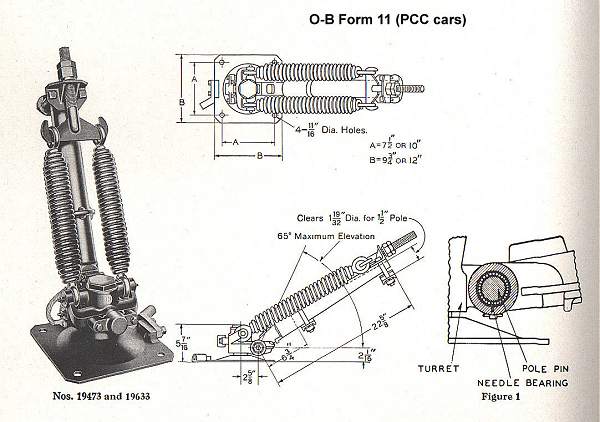
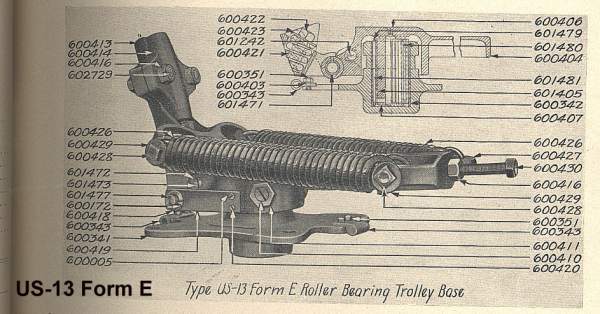
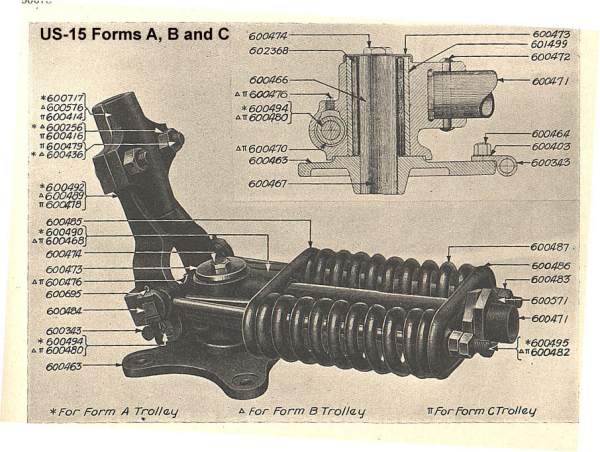

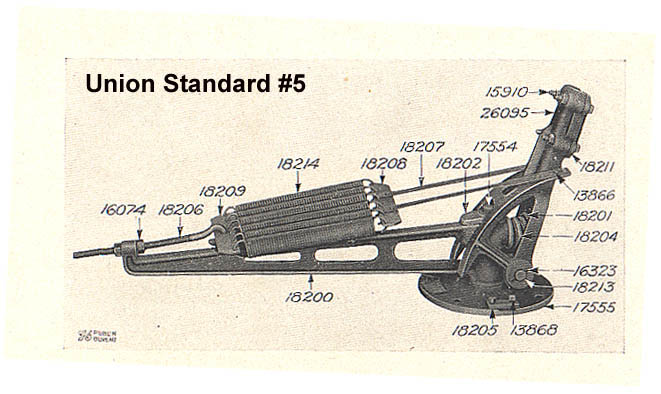
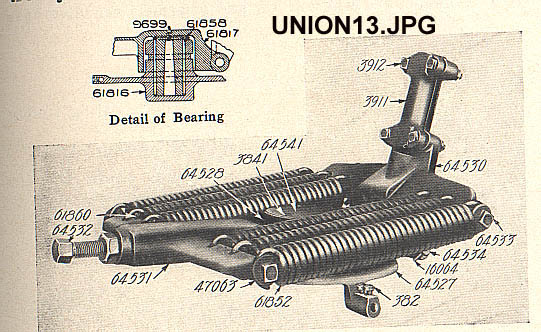
PROCEDURE
After experimenting with poles sold by PSM, Suydam, and Model Tramway over many years, I finally found the best poles to use were provided by Fairfield Models (Bert Sas). These poles had the one feature that I soon found almost mandatory for sustained powered overhead operation on any trolley pike. They can not be permanently mounted to the car in such a manner that the car must be disassembled in order to change or repair any trolley pole. They are better slipped into a brass bushing that is permanently mounted in and insulated from the roof of the car. MTS Imports, Inc. has recently adopted this type of pole base as their baseline for pole production. See Figure 1. This worked fine for the Fairfield models that I was purchasing by subscription in the 1970s such as the Chicago Pullman, the Brooklyn Peter Witt and the Pittsburgh Jones car. All of these came with the standard Fairfield poles with the brass turning on the ends as simulated trolley wheels, although greatly oversize. When I began modeling PERy by using the then ubiquitous Suydam models and more recently, the "F" line PCC cars in San Francisco, I was forced to develop a method of converting both Suydam and Bowser poles to similar style mount. When the Southern California Traction Club was formed in 1995, this type of pole base became mandatory for easy pole replacement and for prevention of damage to overhead wires. The procedure which follows details the steps needed.

We will be describing a method for converting both Bowser and Suydam poles as shown in Figures 2 and 7. Figure 2 shows the major two styles of Suydam poles available during the 1970's and early 1980's, one being the normal spring base pole and the other being the simulated pneumatic base trolley pole as used extensively on the Pacific Electric Railway and for a limited time on some other roads. Figure 7 shows the stock Bowser poles.
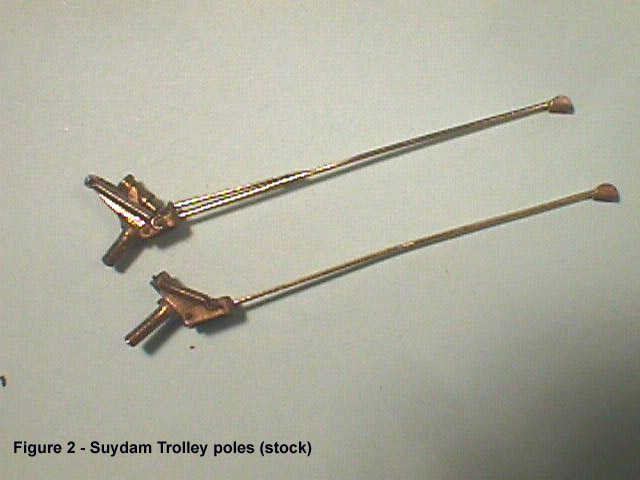
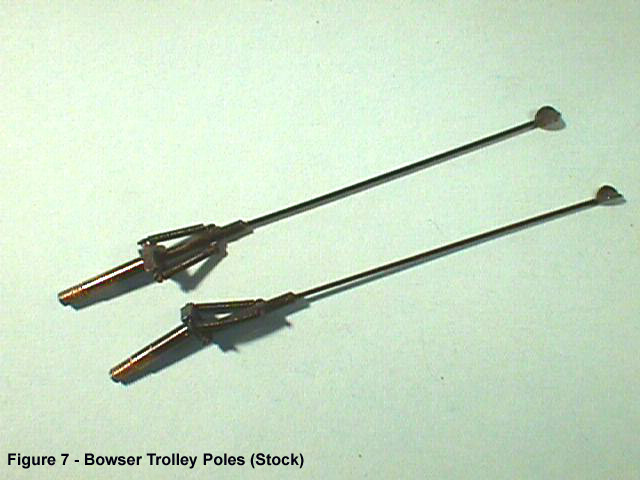
1. In all cases, the first step is to cut the mounting screw off at the base of the pole and file the base flat, noting where the center of the former attaching point was for future reference. See Figures 3 and 8.
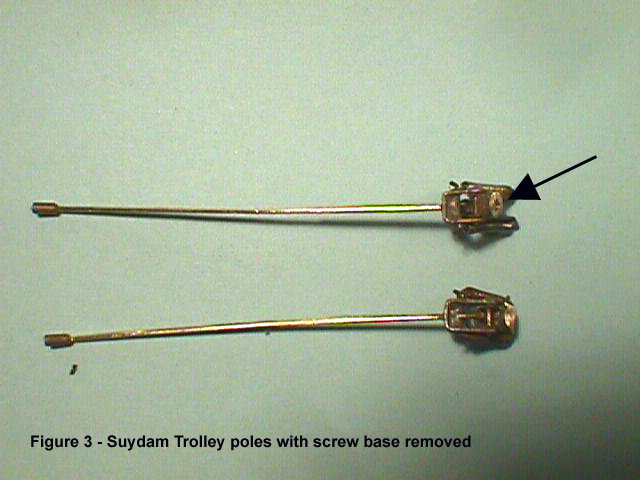
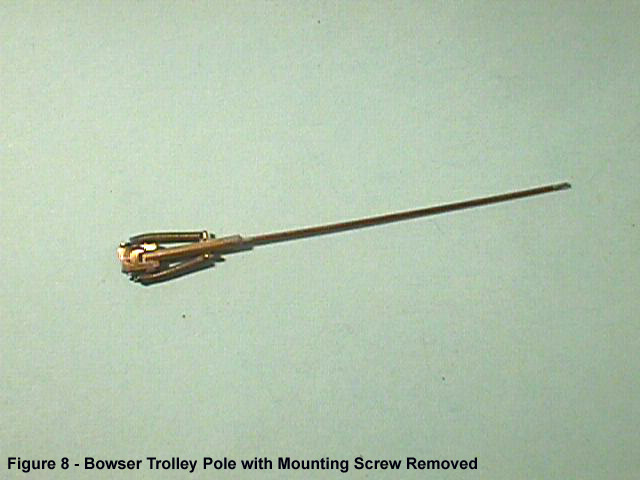
2. The next step is to drill a hole in the center of the bottom of the base to accept a 1 mm (.039") brass rod. A great source of this material is Detail Associates #WR 2510 .040" brass rod. Use a #60 drill to get a .043" hole. By whatever technical means that you feel adequate, ensure that the hole is drilled perfectly perpendicular to the base of the pole or you will have problems at overhead frogs. Note that in Figure 3 the arrow is pointing to the trolley pole base with the hole already drilled for the rod. This rod will fit perfectly into most of the brass bushings which accompanied poles imported by Fairfield (Bert Sas) and S. Soho in the 1970s. These bushings are T shaped with a total height of 5.2mm (.208"), width of 2mm (.077") with a 3mm (.125") collar at the top. The opening in the bushing is a little larger than 1mm (.041"). See Figure 5 for photographs of both the bushing and the roof insulator used to insulate the pole from the normally grounded car. In the case of the Suydam poles, this is accomplished in the same location as the former screw. In the case of the Bowser pole, this must be moved to the center of the base of the U shaped base. There is a problem in drilling through the base at this point as you will drill through the brad the holds the springs and this will can allow the springs to become dislodged. I solved this problem by soldering the ends of the brads to the base prior to drilling the #60 hole. (We should probably mention here that both the brass bushings and the roof insulators are available from Custom Traxx as parts SCTC-1 and SCTC-2, respectively. There is also a conversion kit available, SCTC-3, for trolley poles which includes SCTC-1, SCTC-2 and a length of 1 mm wire.)
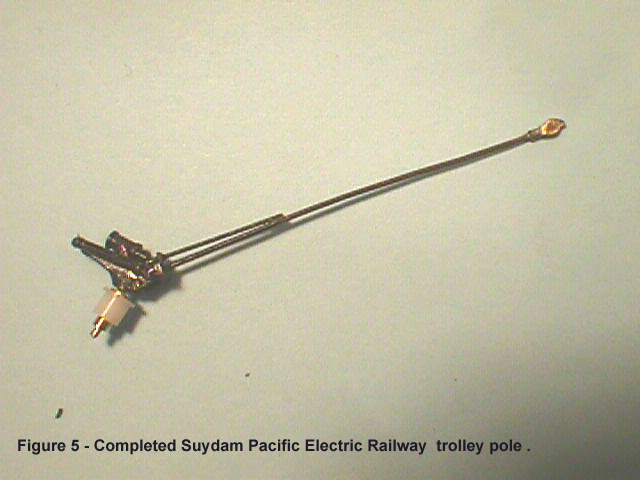
3. At this point, you may want to change to the slimmer pole to improve the look of your model. Most of the trolley pole stock provided with models, especially the older ones are far too great in diameter. Actual trolley poles were about 1.75 inches in diameter and taper down to 3/4" where the shoe or trolley wheel is attached. 1.75 inches is about .020 inches in HOscale. So I have procured K&S .020" music wire, part #370-0499, which is available in 36 inch lengths. If you are uncomfortable with the amount of flexibility in that thin a wire, you may prefer .025" music wire, part #370-0500. I normally cut the wire into 2.25" lengths so I get 16 trolley pole replacements from each wire purchased.
Note: At this point, it is wise to consider the prototype length of the trolley pole versus the model pole. I always begin by modeling the prototype trolley pole length if I can find the data. Most prototype trolley poles are from 13 to 14 feet long, not including the base or the trolley wheel or shoe. Poles were available in length from 8 to 17 feet from the various manufacturers. For the record, the Los Angeles Railway (LARy) standard trolley pole was 13 feet long while the standard Pacific Electric (PERy) trolley pole was 14 feet long. If I can't find the prototype trolley pole length exactly, I will eyeball that dimension from photographs by estimating how far the pole protrudes from the end of the car when under the pole hook. This can be misleading as in some cases, notably the Suydam PERy #414 and #1300 models, the trolley pole has been placed in the correct location for the car as it was in San Diego but in the wrong position for the cars in PERy service. Very often, I found the model pole to be too long and I had to cut the surplus length from the pole. When I found the poles too short, I had to fabricate a new pole from some spring wire. This wire is easy to "blacken" using 'Blacken-It' or other such commercially available 'blackeners'. I prefer this method to painting the poles as the paint rubs off or is scratched off during operation anyway.
4. On the Southern California Traction Club (SCTC), we use mainly the Precision Scale Trolley Wheels, part #31879 or Trolley Shoes, part #31880, to contact the overhead wire. Although those brass turnings that accompany many brass imported models are allowed, both Suydam and Bowser fabricated shoes are currently forbidden. The two Precision Scale parts are made of bronze, last longer and avoid having solder contact the overhead wire and encourage dirty wire.
5. To install these parts, first drill out the hole in the base of the trolley wheel or shoe casting. Drill out this hole to a depth of no more than 1/16" using a #75 drill for .020 wire poles or a #71 drill for .025 poles. Tin the end of the pole and solder the casting to the pole. Ensure that the shoe or wheel is positioned perfectly horizontal (x-axis) and vertical (y-axis) on the pole or you may experience problems at overhead frogs.
6. Figure 4 shows completed Suydam poles. Figure 9 shows a completed Bowser pole.
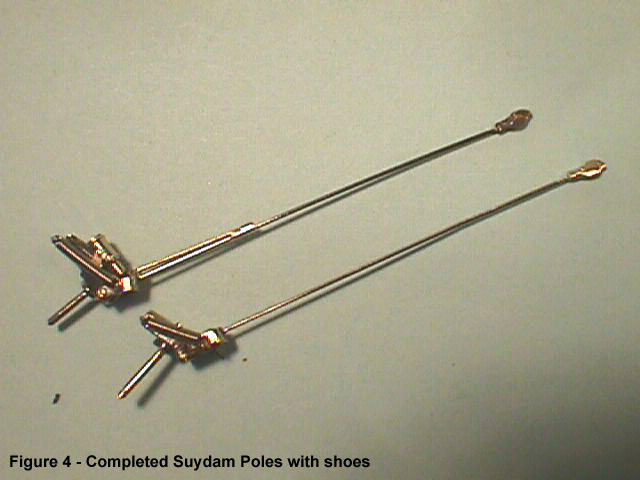
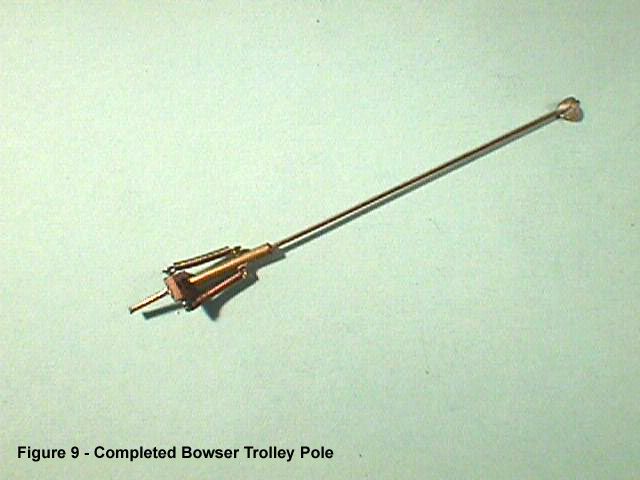
Should you have questions, comments or additions that you feel should be a part of this article, please contact Custom Traxx at P.O. Box 641175, West Los Angeles, CA 90064-1175 or E-mail to:traxx@earthlink.net